Research on Regional Disparities, Dynamic Evolution, and Influencing Factors of Water Environment Governance Efficiency in China
Abstract
1. Introduction
2. Materials and Methods
2.1. Data Sources
2.2. Model Formulation
2.2.1. Super-SBM Model
2.2.2. Dagum Gini Coefficient
2.2.3. Kernel Density Estimation
2.2.4. Convergence Models
2.2.5. Tobit Model
2.3. Index Selection
2.3.1. Input–Output Indicators
2.3.2. Influence Factor Indicators
3. Results
3.1. Temporal and Spatial Evolution of WEGE in China
3.1.1. Characteristics of Temporal Evolution
3.1.2. Characteristics of Spatial Evolution
3.2. Regional Differences in WEGE in China
3.3. Dynamic Evolution of WEGE
3.4. Convergence Analysis of WEGE
3.4.1. σ-Convergence Test
3.4.2. β-Convergence Test
3.5. Analysis of the Influencing Factors of WEGE
4. Discussion
5. Conclusions
Author Contributions
Funding
Data Availability Statement
Conflicts of Interest
Abbreviations
| WEGE | Water Environment Governance Efficiency |
References
- Scanlon, B.R.; Fakhreddine, S.; Rateb, A.; de Graaf, I.; Famiglietti, J.; Gleeson, T.; Grafton, R.Q.; Jobbagy, E.; Kebede, S.; Kolusu, S.R.; et al. Global water resources and the role of groundwater in a resilient water future. Nat. Rev. Earth Environ. 2023, 4, 87–101. [Google Scholar] [CrossRef]
- Bochynska, S.; Duszewska, A.; Maciejewska-Jeske, M.; Wrona, M.; Szeliga, A.; Budzik, M.; Szczesnowicz, A.; Bala, G.; Trzcinski, M.; Meczekalski, B.; et al. The impact of water pollution on the health of older people. Maturitas 2024, 185, 107981. [Google Scholar] [CrossRef] [PubMed]
- Pahl-Wostl, C.; Knieper, C.; Lukat, E.; Meergans, F.; Schodereret, M.; Schütze, N.; Schweigatz, D.; Dombrowsky, I.; Lenschow, A.; Stein, U.; et al. Enhancing the capacity of water governance to deal with complex management challenges: A framework of analysis. Environ. Sci. Policy 2020, 107, 23–35. [Google Scholar] [CrossRef]
- Han, H.; Guo, L.; Zhang, J.; Zhang, K.; Cui, N. Spatiotemporal analysis of the coordination of economic development, resource utilization, and environmental quality in the Beijing-Tianjin-Hebei urban agglomeration. Ecol. Indic. 2021, 127, 107724. [Google Scholar] [CrossRef]
- Abbas, M.; Zhao, L.; Wang, Y. Perspective impact on water environment and hydrological regime owing to climate change: A review. Hydrology 2022, 9, 203. [Google Scholar] [CrossRef]
- Woodhouse, P.; Muller, M. Water governance—An historical perspective on current debates. World Dev. 2017, 92, 225–241. [Google Scholar] [CrossRef]
- Jiménez, A.; Saikia, P.; Giné, R.; Avello, P.; Leten, J.; Lymer, L.L.; Schneider, K.; Ward, R. Unpacking water governance: A framework for practitioners. Water 2020, 12, 827. [Google Scholar] [CrossRef]
- Abellán, J.; Alonso, J.A. Promoting global access to water and sanitation: A supply and demand perspective. Water Resour. Econ. 2022, 38, 100194. [Google Scholar] [CrossRef]
- Wang, H.; Xiong, J. Governance on water pollution: Evidence from a new river regulatory system of China. Econ. Model. 2022, 113, 105878. [Google Scholar] [CrossRef]
- Ouyang, R.; Mu, E.; Yu, Y.; Chen, Y.; Hu, J.; Tong, H.; Cheng, Z. Assessing the effectiveness and function of the water resources tax policy pilot in China. Environ. Dev. Sustain. 2024, 26, 2637–2653. [Google Scholar] [CrossRef]
- Wang, S.; Chen, W.; Wang, R.; Zhao, T. Study on the coordinated development of urbanization and water resources utilization efficiency in China. Water Supply 2022, 22, 749–765. [Google Scholar] [CrossRef]
- Wang, Y.; Shi, Y.; Xu, X.; Zhu, Y. A Study on the Efficiency of Green Technology Innovation in Listed Chinese Water Environment Treatment Companies. Water 2024, 16, 510. [Google Scholar] [CrossRef]
- Lozano, S.; Borrego-Marín, M.M. A metafrontier network DEA approach for water usage efficiency assessment in the light of SDG target 6.4. Environ. Sci. Policy 2024, 160, 103857. [Google Scholar] [CrossRef]
- Haefner, A. Water governance in the Mekong region: The role and impact of civil society organizations. Water Int. 2024, 49, 310–317. [Google Scholar] [CrossRef]
- Yuan, L.; Wu, X.; He, W.; Kong, Y.; Ramsey, T.S.; Degefu, D.M. A multi-weight fuzzy methodological framework for allocating coalition payoffs of joint water environment governance in transboundary river basins. Water Resour. Manag. 2022, 36, 3367–3384. [Google Scholar] [CrossRef]
- Liu, X.; Wang, X.; Lu, F.; Liu, S.; Chen, K. Evaluation of the governance efficiency of water environmental governance efficiency in Yangtze River Delta from the perspective of multivariate synergies. Int. J. Environ. Res. Public Health 2022, 19, 2347. [Google Scholar] [CrossRef] [PubMed]
- Yang, G.; Yang, D. Investigating industrial water-use efficiency in mainland China: An improved SBM-DEA model. J. Environ. Manag. 2020, 270, 110859. [Google Scholar]
- Yu, J.; Xian, Q.; Cheng, S.; Chen, J. Horizontal ecological compensation policy and water pollution governance: Evidence from cross-border cooperation in China. Environ. Impact Assess. Rev. 2024, 105, 107367. [Google Scholar] [CrossRef]
- Ahopelto, L.; Sojamo, S.; Belinskij, A.; Soininen, N.; Keskinen, M. Water governance for water security: Analyzing institutional strengths and challenges in Finland. Int. J. Water Resour. Dev. 2024, 40, 153–173. [Google Scholar] [CrossRef]
- Sadat, M.A.; Guan, Y.; Zhang, D.; Shao, G.; Cheng, X.; Yang, Y. The associations between river health and water resources management lead to the assessment of river state. Ecol. Indic. 2020, 109, 105814. [Google Scholar] [CrossRef]
- Tan, C.; Yu, M.; Wang, J.; Geng, S.; Niu, D.; Tan, Z. Feasibility study on the construction of multi-energy complementary systems in rural areas—Eastern, central, and western parts of China are taken as examples. Energy 2022, 249, 123571. [Google Scholar] [CrossRef]
- Zhang, H.; Song, Y.; Zhang, M.; Ye, D. Land use efficiency and energy transition in Chinese cities: A cluster-frontier super-efficiency SBM-based analytical approach. Energy 2024, 304, 132049. [Google Scholar] [CrossRef]
- Lee, H.S. An integrated model for SBM and Super-SBM DEA models. J. Oper. Res. Soc. 2021, 72, 1174–1182. [Google Scholar] [CrossRef]
- Yuna, D.; Lu, Y.; Razzaq, A. International Differences and Dynamic Evolution of Trade in Digitally Deliverable Services in Global Technological Spectrum. Technol. Soc. 2024, 81, 102781. [Google Scholar]
- Dagum, C.A. New approach to the decomposition of the Gini income inequality ratio. Technol. Soc. 1997, 22, 515–531. [Google Scholar] [CrossRef]
- Kucukpehlivan, T.; Cetin, M.; Aksoy, T.; Kurkcuoglu, M.A.S.; Cabuk, S.N.; Pekkan, O.I.; Dabanli, A.; Cabuk, A. Determination of the impacts of urban planning of the urban land area using GIS hotspot analysis. Comput. Electron. Agric. 2023, 210, 107935. [Google Scholar] [CrossRef]
- Cifuentes-Faura, J.; Fülöp, M.T.; Topor, D.I. Financial autonomy in Spanish local governments: Empirical evidence of beta and sigma convergence. Int. Rev. Admin. Sci. 2024, 90, 599–614. [Google Scholar] [CrossRef]
- Shi, P.; Huang, Q. Assessing the evolution and convergence of energy-related carbon emission efficiency in the Yangtze River Economic Belt. Process Saf. Environ. Prot. 2024, 191, 1684–1695. [Google Scholar] [CrossRef]
- Dalei, N.N.; Joshi, J.M. Estimating technical efficiency of petroleum refineries using DEA and tobit model: An India perspective. Comput. Chem. Eng. 2020, 142, 107047. [Google Scholar] [CrossRef]
- Khan, S.U.; Cui, Y.; Khan, A.A.; Ali, M.A.; Khan, A.; Xia, X.; Liu, G.; Zhao, M. Tracking sustainable development efficiency with human-environmental system relationship: An application of DPSIR and super efficiency SBM model. Sci. Total Environ. 2021, 783, 146959. [Google Scholar] [CrossRef] [PubMed]
- Nyangchak, N. Assessing renewable energy efficiency and policies: A combined analysis of LMDI, super-SBM, and fieldwork in Qinghai, China. Energy Sustain. Dev. 2024, 80, 101420. [Google Scholar] [CrossRef]
- Huang, Y.; Huang, X.; Xie, M.; Cheng, W.; Shu, Q. A study on the effects of regional differences on agricultural water resource utilization efficiency using super-efficiency SBM model. Sci. Rep. 2021, 11, 9953. [Google Scholar] [CrossRef]
- Liang, X.; Li, J.; Guo, G.; Li, S.; Gong, Q. Evaluation for water resource system efficiency and influencing factors in western China: A two-stage network DEA-Tobit model. J. Clean. Prod. 2021, 328, 129674. [Google Scholar] [CrossRef]
- Permani, R. Do online agri-food sellers contribute to food security in Indonesia? A PCA-based composite index and a Tobit approach. Food Sec. 2023, 15, 1541–1561. [Google Scholar] [CrossRef]
- Buendía, H.A.; André, F.J.; Santos-Arteaga, F.J. On the Evolution and Determinants of Water Efficiency in the Regions of Spain. Water Resour. Manag. 2024, 38, 3093–3112. [Google Scholar] [CrossRef]
- Zhu, Q.; Cao, Y. Research on provincial water resources carrying capacity and coordinated development in China based on combined weighting TOPSIS mode. Sci. Rep. 2024, 14, 12497. [Google Scholar]
- Peng, G.; Zhang, X.; Liu, F.; Ruan, L.; Tian, K. Spatial–temporal evolution and regional difference decomposition of urban environmental governance efficiency in China. Environ. Dev. Sustain. 2021, 23, 8974–8990. [Google Scholar] [CrossRef]
- Wu, R.; Gesang, D.; Zhou, G.; Li, Y. Spatial disparities and dynamic evolution of professional public health resource supply level in Beijing, China. BMC Public Health 2024, 24, 2524. [Google Scholar] [CrossRef] [PubMed]
- Distefano, T.; Isaza, A.S.; Morlin, G.S.; Carmona, V.P.; Palacio, C.I.V.; Arango-Aramburo, S. The roads towards complex water governance: The Colombian case study. World Dev. 2025, 188, 106874. [Google Scholar] [CrossRef]
- Wan Ahmad Tajuddi, W.A.N.; Zainon Noor, Z.; Weng Wai, C.; Azmi, A.; Mohsen, N.; Zulfaqar, S.; Jaime, A.; Abdul Wahid, N.A. Framing a social network analysis approach to understanding reputational power in the water governance of Johor, Malaysia. J. Water Clim. Change 2023, 14, 3891–3911. [Google Scholar] [CrossRef]
- Kar, A.K.; Choudhary, S.K.; Singh, V.K. How can artificial intelligence impact sustainability: A systematic literature review. J. Clean. Prod. 2022, 376, 134120. [Google Scholar] [CrossRef]
- Arfa, A.; Ayyoubzadeh, S.A.; Shafizadeh-Moghadam, H.; Mianabadi, H. Transboundary hydropolitical conflicts and their impact on river morphology and environmental degradation in the Hirmand Basin, West Asia. Sci. Rep. 2025, 15, 2754. [Google Scholar] [CrossRef] [PubMed]
- Tenaw, D.; Beyene, A.D. Environmental sustainability and economic development in sub-Saharan Africa: A modified EKC hypothesis. Renew. Sust. Energ. Rev. 2021, 143, 110897. [Google Scholar] [CrossRef]
- Jayasiri, M.M.J.G.C.N.; Yadav, S.; Dayawansa, N.D.K.; Ingold, K. Managing agricultural water resources: Addressing the complexity of innovation, social perspectives, and water governance in Sri Lanka. Irrig. Drain. 2022, 71, 71–85. [Google Scholar] [CrossRef]
- Millington, N.; Scheba, S. Day zero and the infrastructures of climate change: Water governance, inequality, and infrastructural politics in Cape Town’s water crisis. Int. J. Urban Reg. Res. 2021, 45, 116–132. [Google Scholar] [CrossRef]
- Yin, F.; Shi, X.; Guo, H.; Shen, Y. Performance evaluation of rural water environment governance based on AHP: A case study of the Beitang River Basin. Water Sci. Technol. 2023, 88, 2661–2676. [Google Scholar] [CrossRef] [PubMed]
- Zha, Q.; Liu, Z.; Wang, J. Spatial pattern and driving factors of synergistic governance efficiency in pollution reduction and carbon reduction in Chinese cities. Ecol. Indic. 2023, 156, 111198. [Google Scholar] [CrossRef]
- Sun, H.; Kporsu, A.K.; Taghizadeh-Hesary, F.; Edziah, B.K. Estimating environmental efficiency and convergence: 1980 to 2016. Energy 2020, 208, 118224. [Google Scholar] [CrossRef]
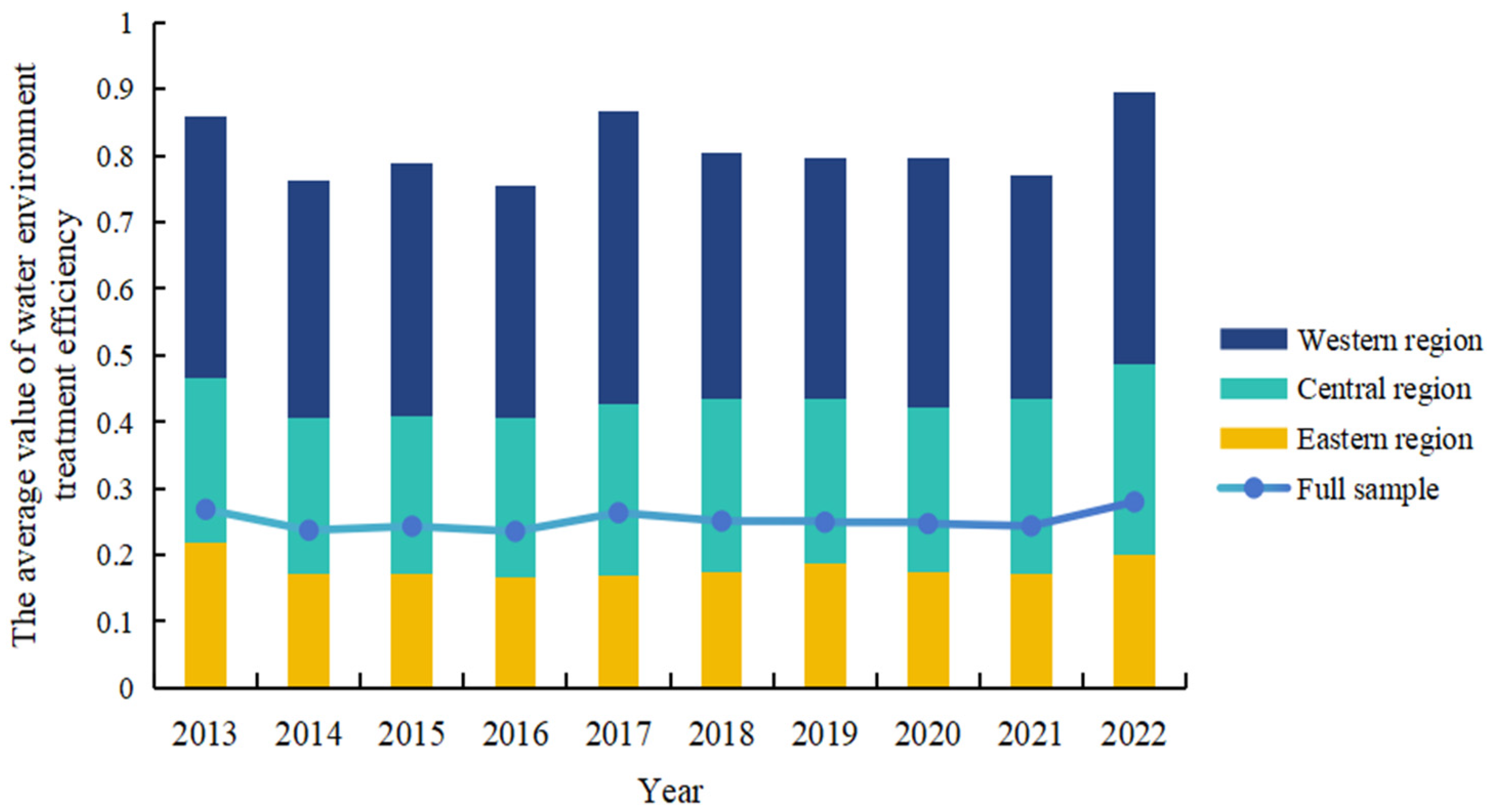
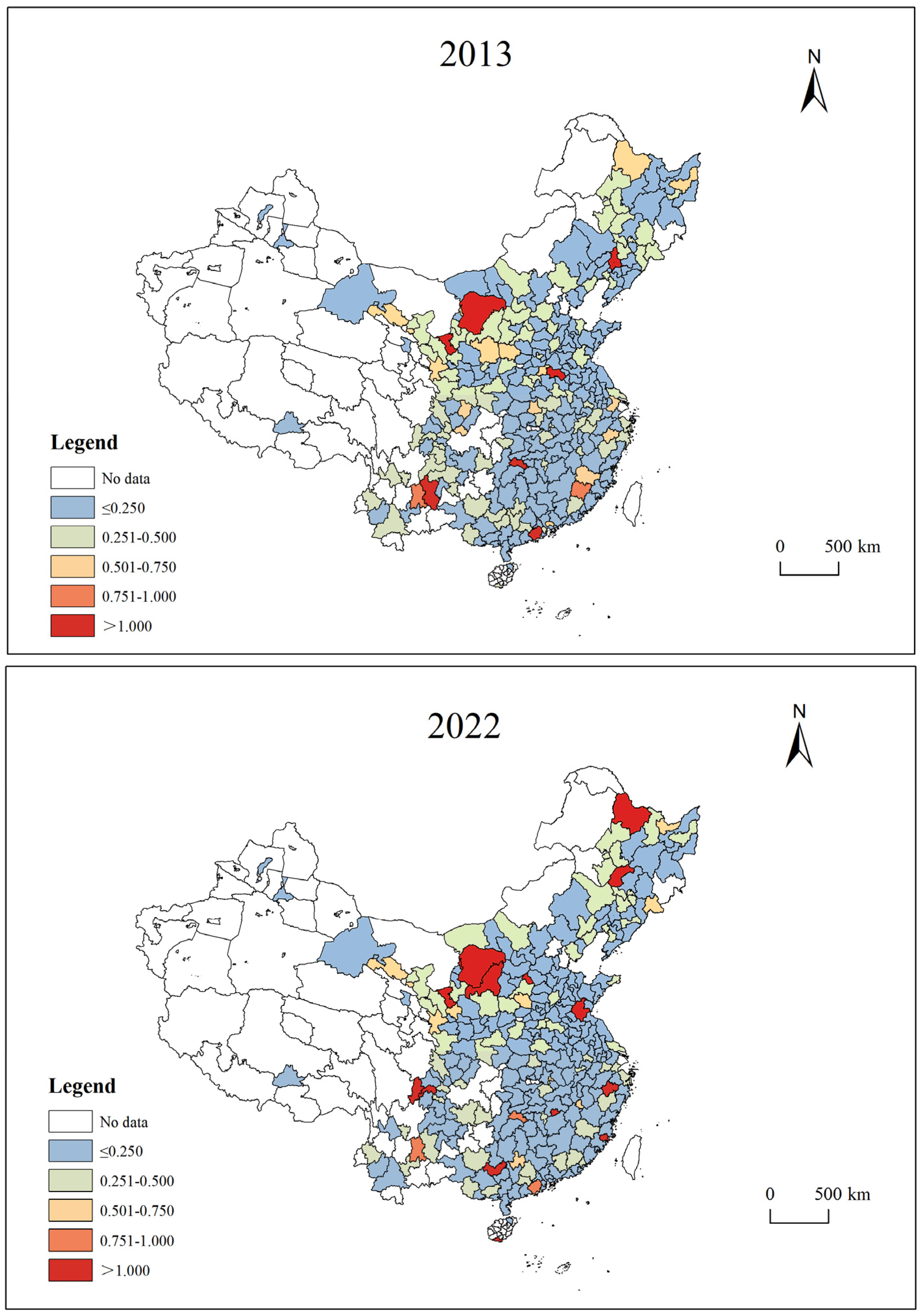
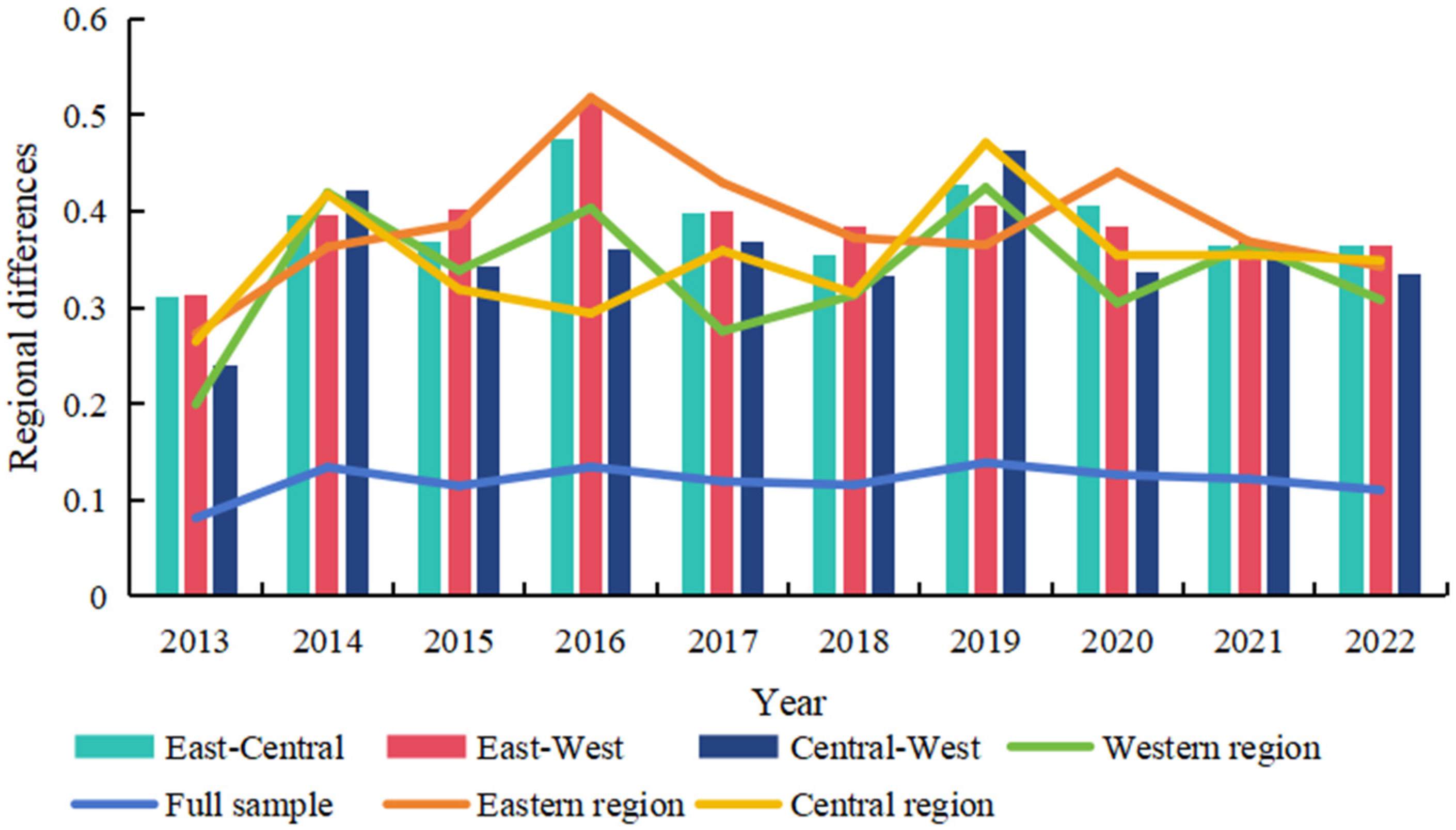
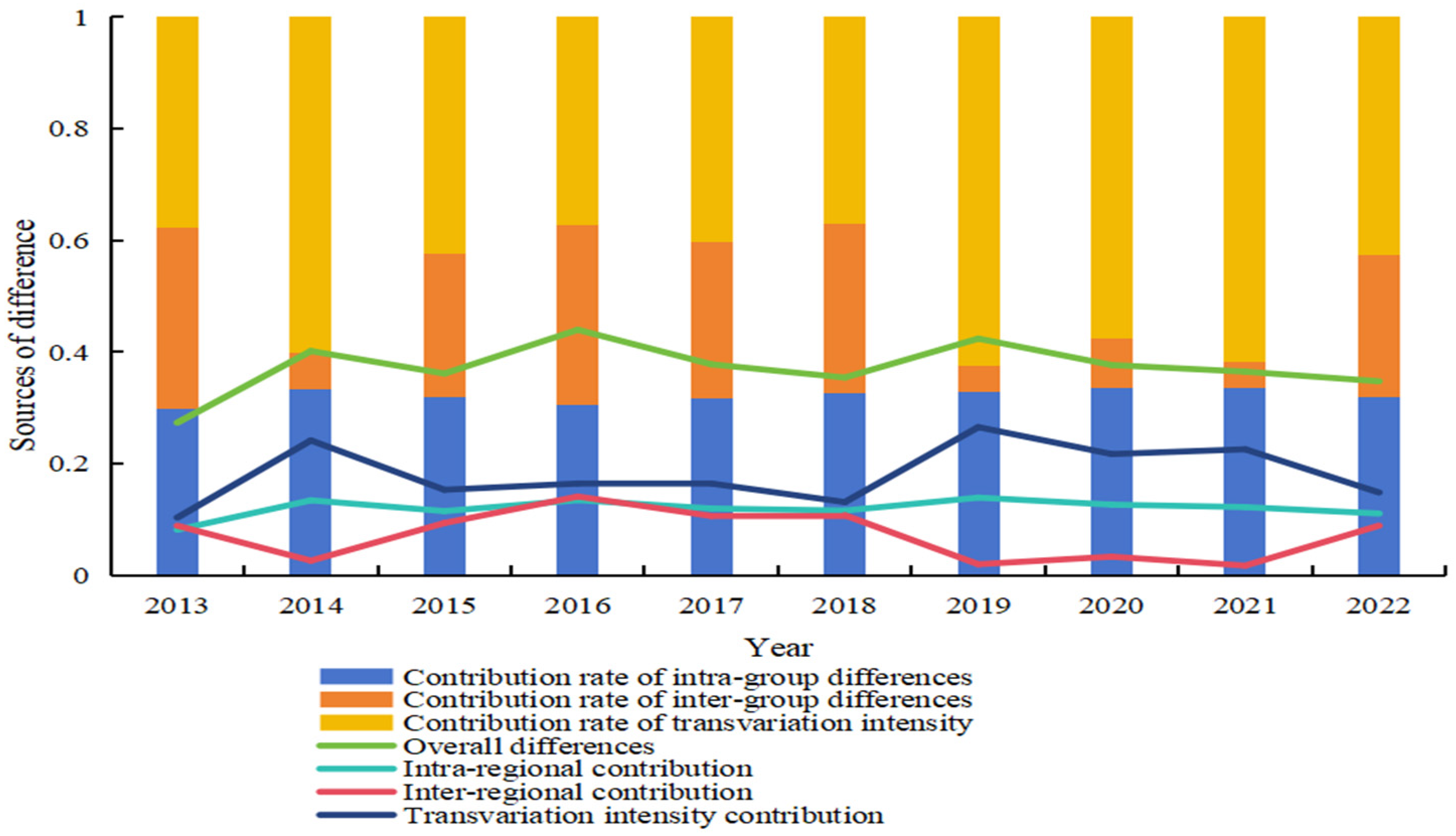
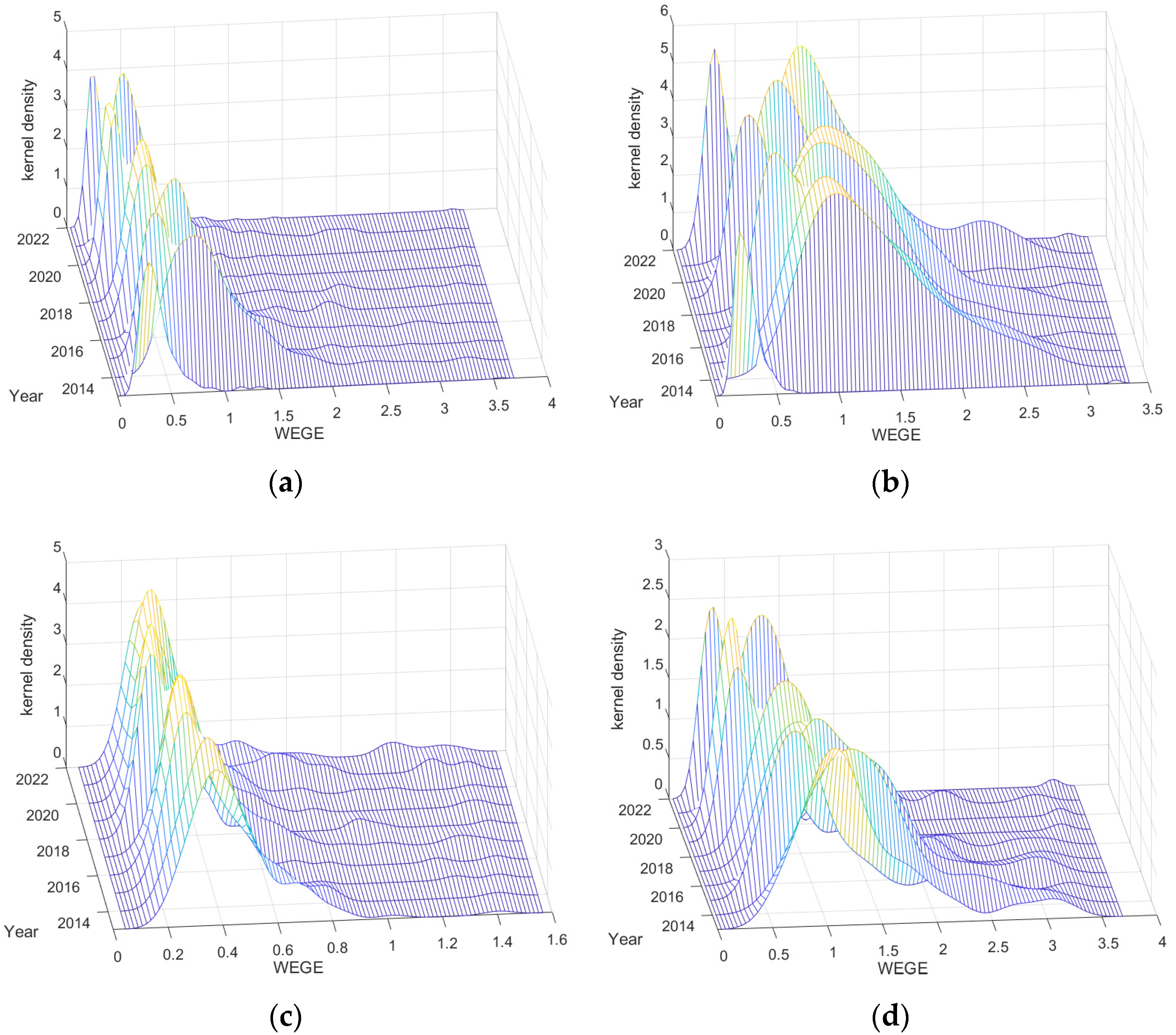
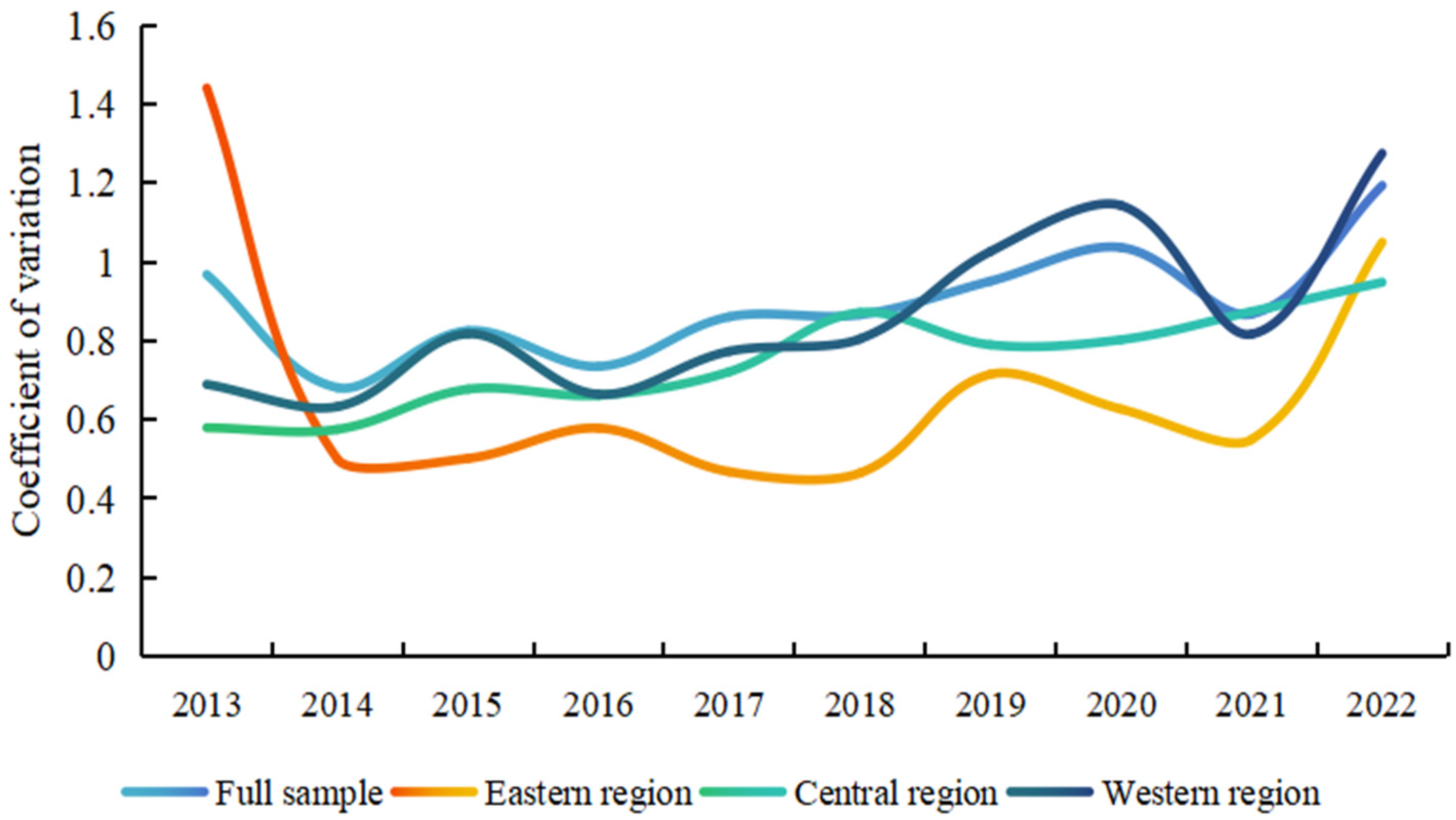
| Primary Indicators | Secondary Indicators | Unit |
|---|---|---|
| Input | Investment in water environment governance | CNY 10,000 |
| The number of employees in the water conservancy, environment, and public facilities management industries | 10,000 people | |
| The density of water pipelines in the built-up area | km/104 km3 | |
| The daily sewage treatment capacity of the city | 104 m3/d | |
| Water consumption | 104 m3 | |
| Desirable output | Sewage treatment rate | % |
| Per capita GDP | CNY 10,000 per person | |
| Undesirable output | Sewage discharge volume | 104 m3 |
| Indicator | Full Sample | Eastern Region | Central Region | Western Region |
|---|---|---|---|---|
| β | −0.779 *** (−35.98) | −0.96 *** (−42.02) | −0.571 *** (−17.33) | −0.781 *** (−14.67) |
| cons | 0.178 *** (16.86) | 0.164 *** (18.02) | 0.128 *** (9.46) | 0.272 *** (7.16) |
| N | 2830 | 1110 | 1090 | 630 |
| R2 | 0.372 | 0.675 | 0.265 | 0.324 |
| Convergence or not | Yes | Yes | Yes | Yes |
| Indicator | Full Sample | Eastern Region | Central Region | Western Region |
|---|---|---|---|---|
| β | −0.782 *** (−35.99) | −0.968 *** (−41.94) | −0.580 *** (−17.51) | −0.811 *** (−14.80) |
| C1 | −0.028 ** (−2.06) | −0.026 * (−1.88) | 0.006 (0.43) | −0.112 ** (−2.42) |
| C2 | −0.386 (−1.08) | −0.340 (−1.19) | −1.200 ** (−2.40) | −0.687 (−0.50) |
| C3 | −0.066 (−1.35) | −0.097 ** (−2.29) | −0.72 (−1.19) | 0.143 (0.70) |
| C4 | −0.008 (−0.14) | −0.136 ** (−2.25) | −0.035 (−0.35) | 0.450 * (1.84) |
| cons | 0.237 *** (6.04) | 0.321 *** (6.85) | 0.184 *** (4.18) | 0.159 (0.29) |
| N | 2830 | 1110 | 1090 | 630 |
| R2 | 0.378 | 0.681 | 0.272 | 0.335 |
| Convergence or not | Yes | Yes | Yes | Yes |
| Variable | Regression Coefficient | Z-Value | p-Value |
|---|---|---|---|
| gov | 0.116 ** | (1.98) | 0.047 |
| ai | −0.033 ** | (−2.48) | 0.013 |
| pop | −0.095 *** | (−9.95) | 0.000 |
| Ind | −0.130 ** | (−2.36) | 0.018 |
Disclaimer/Publisher’s Note: The statements, opinions and data contained in all publications are solely those of the individual author(s) and contributor(s) and not of MDPI and/or the editor(s). MDPI and/or the editor(s) disclaim responsibility for any injury to people or property resulting from any ideas, methods, instructions or products referred to in the content. |
© 2025 by the authors. Licensee MDPI, Basel, Switzerland. This article is an open access article distributed under the terms and conditions of the Creative Commons Attribution (CC BY) license (https://creativecommons.org/licenses/by/4.0/).
Share and Cite
Zhao, X.; Yang, D. Research on Regional Disparities, Dynamic Evolution, and Influencing Factors of Water Environment Governance Efficiency in China. Water 2025, 17, 515. https://doi.org/10.3390/w17040515
Zhao X, Yang D. Research on Regional Disparities, Dynamic Evolution, and Influencing Factors of Water Environment Governance Efficiency in China. Water. 2025; 17(4):515. https://doi.org/10.3390/w17040515
Chicago/Turabian StyleZhao, Xiaochun, and Danjie Yang. 2025. "Research on Regional Disparities, Dynamic Evolution, and Influencing Factors of Water Environment Governance Efficiency in China" Water 17, no. 4: 515. https://doi.org/10.3390/w17040515
APA StyleZhao, X., & Yang, D. (2025). Research on Regional Disparities, Dynamic Evolution, and Influencing Factors of Water Environment Governance Efficiency in China. Water, 17(4), 515. https://doi.org/10.3390/w17040515





